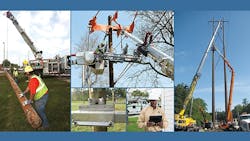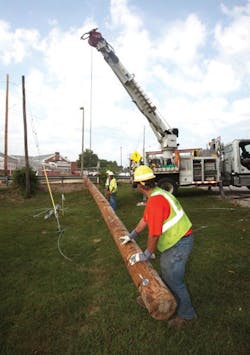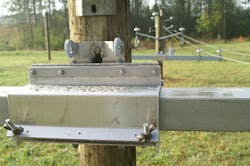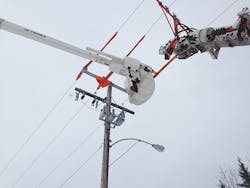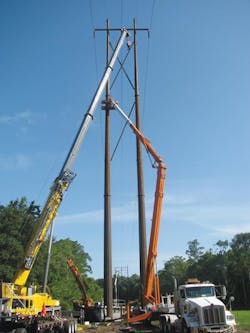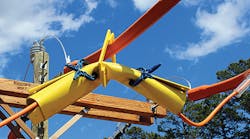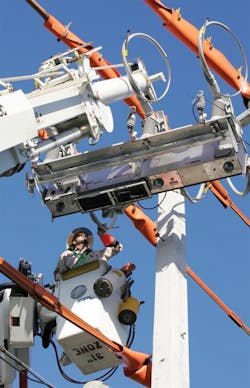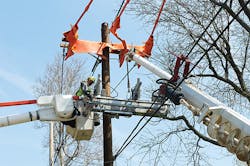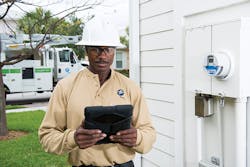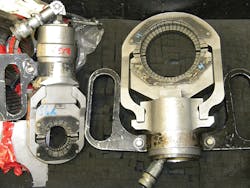Linemen Rebuild for Future Energy Needs
Over the last 40 years, Michael Glueckert Sr. has helped his brothers and sisters in the line trade to build out the nation’s infrastructure. Today, linemen are faced with a new challenge: to meet the insatiable demand for power by rebuilding, hardening and expanding the system nationwide.
“Right now, our whole country is being rebuilt and new lines are being planned,” said Glueckert, a journeyman for NorthWestern Energy in Helena, Montana, and a member of the National Lineman Hall of Fame. “Over the next 10 to 12 years, the transmission lines and infrastructure of America will be strengthened.”
Because of the rebuilding effort, some utilities may have more work than they can handle. As a result, linemen may be challenged to do more work with fewer resources. To boost power reliability and minimize repair times, utilities are installing more robust infrastructure to guard against storm-related outages, increasingly performing live-line work, installing wildlife protection devices and deploying smart meter technology.
Hardening the System
As utilities are replacing aging assets, their field workforce is installing more robust infrastructure that can handle severe storm events and stand the test of time.
Across North America, utilities are embarking on major infrastructure rebuild projects, such as NorthWestern Energy, which owns and operates the oldest steel transmission line west of the Mississippi. Some of the structures date back to 1908, and, while they are still standing and in good condition, the utility is replacing deteriorating structures with larger-class poles with steel arms. Linemen are also shortening the span between poles and installing high-strength wire.
“We can carry twice the amperage and voltage with a simple reconductor changeout,” Glueckert said. “If we have a rough ice storm, things will come down, but we are trying to mitigate it so we can quickly come back in and put things back together.”
Other utilities also have significant reconductoring projects underway, and, as linemen drill more and more holes into poles, they may find the crossarms are too weak to hold heavy conductors. To solve this problem, Tony Kiser, a distribution trainer at Georgia Power, invented the Temporary Arm Gain and Insulator Saddle. The non-boring support is designed to be used specifically with a fiberglass arm and allows the conductors to be mounted without the drilling of additional holes.
Linemen are not only increasing the capacity of their lines through reconductoring, but they also are improving reliability by replacing rotted wood crossarms and poles with structures made from other materials. For example, SaskPower’s field workforce replaced moss-covered wood crossarms near a lake with polymer crossarms, and Santee Cooper’s crews swapped out some of its wood poles with light-duty steel poles in South Carolina. Santee Cooper’s line crews used a Champion or Hougen magnetic drill to frame the Thomas & Betts/Meyer steel poles, which come in two pieces and are easy to transport, said Mark Marsh, supervisor of transmission for Santee Cooper.
Ameren Illinois also is guarding against storm-related outages by installing fiberglass crossarms from Maclean Power Systems, Power Line Supply, Shakespeare Composite Structures and Fletcher Reinhardt Co., and HD Supply for the dead-end arms. Also, the linemen are installing Trident and Duratel composite poles every fourth or fifth structure on many of the distribution circuits for its 69-kV lines. Because these poles do not require down guys, they can serve as storm structures and prevent the cascading of a line.
To withstand severe storms, Florida Power & Light Co. (FPL) has invested more than $1.4 billion in its hardening program since 2006. Over the last eight years, FPL crews have installed concrete poles and employed design standards to harden the main feeders serving key community facilities, such as hospitals, police and fire stations, and emergency operations centers, to withstand minimum wind gusts of 130 mph.
“In many cases, the system is rated up to 145 mph,” said Dave Herlong, manager of smart grid operations for FPL.
Working Hot
As utilities are replacing aging infrastructure and hardening their systems, they often find it is nearly impossible to take outages on a line. For example, at Santee Cooper, it can be very challenging to get clearances on the 230-kV lines because of high loading in hot or cold weather. Also, some of the cooperatives are not able to backfeed their stations to give the utility clearance on their taps on the 115-kV lines.
Because it is so difficult to get outages, Santee Cooper’s linemen are working live using A.B. Chance and Hastings hot sticks. Through the utility’s internal maintenance program, the linemen keep these hot sticks clean, dry and in top condition.
“We can’t allow any moisture to get to them or it could cause them to break down,” Marsh explained. “There is a certain time when you can do hot work, and it is not during times with high humidity or rain.”
In Montana, NorthWestern Energy line crews also are hot sticking using specialized tools from Chance. Glueckert said through the practice of barehanding, transmission work is now easier for the line crews. “It’s all about keeping our current flowing through the transmission line,” he said.
Another type of technology aiding live-line work on high-voltage transmission lines is the robotic arm. “We are just breaking into that, and it’s still such a new thing,” Glueckert said. “Our sister local unions and the contractors are using these arms in increasing numbers, and in the future, I expect to see more robotic arms used for live-line work.”
One other tool improving the safety of live-line work is called the Tri-Clamp, invented by Bill DePue, west region line maintenance superintendent for the Tri-State Generation and Transmission Association, and sold by JobSite Inc. Linemen can put the clamp on the end of a shotgun stick, and by using it with the patent-pending Boo-Sher socket, they can reduce connecting times on live jumpers by as much as 65%, DePue said.
“On transmission lines, installing energized jumpers is one of the most dangerous jobs,” DePue said. “I’ve been doing it for 40 years, but now that I’m taking charge of younger linemen, I thought there had to be a better way to do it.”
Georgia Power crews also were facing issues when it came to working on energized jumpers, and, as a result, David McQuaig, a distribution supervisor, invented a product called the Mechanical Jumper Aid to support the jumper wire during maintenance and repairs. With this tool, linemen can maintain continuity of electric service temporarily when installing new equipment.
Protecting Wildlife and Minimizing Outages
Along with installing more robust infrastructure, electric utilities also are improving reliability by preventing wildlife-caused outages. For example, squirrels and other critters can inflict significant monetary damage and monumental outages when they sneak into a substation, and birds can land on energized equipment or peck baseball-sized cavities into wood poles.
To extend the life of their assets while protecting the avian wildlife, utilities are implementing a variety of preventive measures. For example, when NorthWestern Energy first started 112 years ago, the linemen built 600-ft spans with high-strength steel wire and H-frame wood structures in its transmission system to keep rates lower for the ratepayer. Now that field crews are rebuilding the infrastructure and shortening the spans, the linemen are installing raptor-proof construction.
In the wintertime, the utility sends out crews to change the construction of some of the existing lines to protect the birds. For example, linemen install high-voltage insulation and smart grid air breaks on the transmission system. To protect the raptors, the system is well insulated and has a greater phase cycle. In addition, the field crews install raptor-insulating hoods on the center phase and all of the conductors on the steel poles. Also, the utility has increased the clearance on its lines so birds can spread their wings and not get killed.
“We are one of the best in the nation when it comes to protecting the birds,” Glueckert said. “It is very personal to us linemen, and we have a lot of compassion for the birds. As our country is growing, we have to live side by side with each other and its creatures, and we are all in this together.”
Other utilities also are taking measures when it comes to avian protection. Ameren Illinois installs 10-ft crossarms to maintain clearances between phases, and linemen install cutout covers, arrester covers and polymer line coating from Tyco Corp. for the jumper wires. Linemen also carry rubber sleeves to place over large conductors and install line guards and polymer covers on the existing lines.
When it comes to transformer design, the entire setup of the apparatus on the pole has changed, said Jason Freeman, electric operations supervisor and journeyman lineman for Ameren Illinois. Now, anything above the secondary bushings on the transformer is covered up with a polymer or rubber coating to make it almost impossible for an animal- or bird-related outage. As a result, the avian protection efforts have not only protected the birds, but also improved customer reliability. Since 2012, Ameren Illinois has retrofitted 1,400 structures on more than 150 circuits in high-density raptor areas and have greatly reduced the number of injured birds of prey.
“When there is a single transformer outage and the power is out, it is usually due to a bird, raccoon or other animal,” Freeman said. “Not only are we protecting the wildlife by covering up our transformers and conductors, but we are also preventing a huge number of outages to keep our customers in service.”
FPL also is taking measures to prevent outages caused by birds and animals. Through its avian protection program, engineers and line crews must evaluate engineering standards for new construction and major maintenance projects to determine if specific avian design and construction standards are required for the location.
FPL has improved avian protection and reduced outage risk through proper spacing of multiple-phase sets of lines, installation of bird flight diverters, cones and other bird discouragers, as well as the installation of avian protection devices on lines and pole-mounted equipment. The devices include covers, spacers and use of insulated line or tough rubber covers on bond wires and jumpers. FPL also has relocated more than 150 osprey nests to new platforms it erected to protect the birds and their fledglings as well as to prevent power outages.
In Santee Cooper’s service territory, buzzards and cranes often land on the infrastructure and woodpeckers inflict damage in the wood poles. To protect its wood poles, linemen fill the cavity with iFoam and then place a cloth canvas over the hole. The iFoam expands into the void and brings it back to 99% of its full strength. Linemen then wrap their poles with a high-grade, mesh metal wire when they see signs of woodpecker damage.
“We do an aerial and ground patrol each year, and if we find wood poles that are damaged by woodpeckers or termites, we can make the pole back to new again with the iFoam,” Marsh said. “If it is beyond repair, then we go ahead and replace it.”
Deploying Smart Technology
Another way utilities are improving customer service and reliability is by installing smart meter technology and related equipment. For example, at Ameren Illinois, linemen are installing a smart grid technology called IntelliRupters from S&C Electric. Unlike automatic reclosers, they can communicate with other pieces of equipment and work in series with three different units spread out over a few different circuits through an IntelliLink system.
“If there is a fault, they can talk to another IntelliRupter and indicate that they need power to come from the other direction,” Freeman explained. “Then within a second or two, power is restored instead of us having to deal with an isolated section of line.”
At FPL, smart grid technology has helped the field crews to improve service to customers by predicting many potential outages and restoring service faster when the power goes out. Crews can now pinpoint the location of outages and speed up repairs. Also, advanced sensors and switches quickly identify an outage and reroute power around the trouble spot, preventing it from spreading to other areas.
Over the last seven years, the utility has deployed 4.6 million smart meters across its 27,000-sq-mile service area. To help its field workforce reap the benefits of the smart grid technology, the utility has invested in ruggedized iPad tablets with a military-grade cover and screen protection.
FPL’s Restoration Spatial View program gives restoration workers crucial information from different systems, providing them with one-stop shopping on their iPads from Apple Inc. The program combines real-time outage information, weather radar and alerts, electrical network information, customer energy usage and voltage. It also provides crews with immediate access to restoration crew location, meter status and more — all layered on a map view.
“After restoring service following an outage, we used to have to walk from house to house or block to block to ensure all customers in the area had service,” said Richard Britt Jr., a line specialist who has been with FPL for more than 10 years. “Today, with our iPads and other tools, we can now find them with a few keystrokes. It has benefitted the customer, minimized outages and reduced downtime because we are more efficient.”
Another key benefit of the technology is the field workforce now knows about an impending failure, like a transformer’s overvoltage condition, before it even happens. The utility aggregates the smart meter data coming from the equipment, and if it is not operating correctly, then it tags the transformer for replacement, schedules the outage and issues a work ticket to the line crews through the wireless area network in their vehicles. So far, FPL has proactively replaced more than 500 transformers, preventing outages for thousands of customers. Also, it has minimized weekend or late-night calls to line crews to replace equipment.
“From a crew member perspective, it has taken the guessing game out of the equation,” Britt said. “When a transformer is about to fail, we can prevent an unnecessary outage. We can see the health of some of this equipment and avoid unnecessary interruptions.”
By investing in the latest tools and technology for their field workforce, utilities are finding ways to improve linemen’s productivity while hardening their systems, replacing aging assets, minimizing outages and deploying smart technology. Glueckert believes opportunities abound for linemen because of the nationwide building effort, and by working together, linemen can help the nation to meet its future energy needs.
“Our linemen numbers in America may double because of the transmission and distribution infrastructure rebuild,” Glueckert said. “Our country will always have a great demand for linemen as we try to achieve uninterruptible power.”
Leveraging the Benefits of New Hand Tools
To keep their field work both safe and productive, electric utilities are investing in specialized hand tools to improve ergonomics. With more work to do with fewer resources, it is imperative for line crews to have the proper tools and technology on hand. Here are some trends when it comes to hand tools for linemen:
1. Eliminate repetitive motion. Florida Power & Light Co. has invested in battery-operated crimpers and cutters; Ameren Illinois has purchased presses, cable cutters and drills; and Xcel Energy has invested in many of these hand tools for its linemen, as well. By buying these ergonomic, labor-saving hand tools for their linemen, these utilities are aiming to reduce the number of sprains and strains as well as save time in the field. “The linemen can’t live without them, and they are the biggest bang for our buck,” said Tom Cascalenda, director of design and construction for Xcel Energy.
2. Provide more power. Michael Glueckert, a journeyman for NorthWestern Energy, said the ergonomic battery-operated tools such as the cutters and presses have made a big difference in his and other linemen’s lives, and he has been impressed with the new load-pickup tools, Gator tools and different types of wrenches out on the market. “The kind of features that they have built into them is something I thought I would never see,” Glueckert said.
3. Can share the same battery pack. Battery-operated impact tools also have been beneficial for Santee Cooper’s line crews, who have been using them for the last three or four years. The utility buys its tools from Milwaukee Tool, and by working with a single vendor, the linemen can use the same battery for all of the tools. Linemen are currently using battery-powered drills, grinders, sawzalls and nut drivers, and these tools have many benefits over the hydraulic equipment. “You don’t have to worry about hydraulic hoses being in your way or bursting and leaking,” said Mark Marsh, supervisor of transmission for Santee Cooper. “Also, they’re quicker than manual tools and a lot more efficient.”
4. Save time. The new hand tools on the market also save a significant amount of time for linemen in the field. For example, Marsh says his crews are gaining unprecedented efficiency from a new tool that can make one compression on a jumper terminal. The old 60-ton presses once made seven or eight mashes on the jumper terminal, and they required linemen to perform the time-consuming task of welding the bus in the substations. Now they can bring in two pieces of bus and, instead of welding it, compress it with a compression-type coupling. “It has really sped up our production and efficiency,” Marsh said. “It’s much different from the old school, when we had to weld everything.”
About the Author
Amy Fischbach
Electric Utilities Operations
Amy Fischbach is the Field Editor for T&D World magazine and manages the Electric Utility Operations section. She is the host of the Line Life Podcast, which celebrates the grit, courage and inspirational teamwork of the line trade. She also works on the annual Lineworker Supplement and the Vegetation Management Supplement as well as the Lineman Life and Lineman's Rodeo News enewsletters. Amy also covers events such as the Trees & Utilities conference and the International Lineman's Rodeo. She is the past president of the ASBPE Educational Foundation and ASBPE and earned her bachelor's and master's degrees in journalism from Kansas State University. She can be reached at [email protected].
